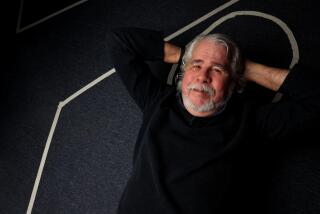Personal Crusade for Better Children’s Theater : Stage: Sundance’s Jerry Patch wants to persuade mainstream writers to address the concerns of young audiences.
When Jerry Patch was named artistic director of the newly launched Sundance Children’s Theatre in Utah late last year, the first thing he did was write to more than 100 playwrights with whom he had worked with in Costa Mesa in his long stint as dramaturg for South Coast Repertory--playwrights who, Patch guessed, probably had never even thought about writing a children’s play before.
He was planting seeds, hoping to entice top mainstream dramatists to address young audiences and thereby help raise the level of children’s theater.
“The whole point is to get the best writers out there,” Patch said, back at his desk at SCR last week, his first season at Sundance--the combination artistic center/resort founded by actor Robert Redford--now behind him.
While the Sundance Children’s Theatre has a production component, now midway through its first season, the emphasis is on development.
“There’s millions of kids going to theater,” Patch said, “and what they’re seeing isn’t very good. Normally, what you get in children’s theater is rewrites of classics. We weren’t really getting new things. That’s not creating a literature for the stage.
“One of the first people I went to,” Patch continued, “was Craig Lucas,” the author of “Blue Windows” and “Prelude to a Kiss,” both of which had premiered at SCR. Lucas said he was too busy to take part this time, but Patch was able to line up Allan Havis, whose “Haut Gout” and “Morocco” also premiered at SCR; Jim Leonard Jr. and Quincy Long, up-and-coming writers with New York productions among their credits (and past SCR commission recipients), and Sandra Deer, dramaturg at the Alliance Theatre in Atlanta.
Patch also signed Laurence Yep, who is adapting his own award-winning children’s book, “Dragonwings,” for the stage. Although it is Yep’s first effort as a playwright, the adaptation already has been selected for production this fall by Berkeley Repertory Theatre. Of 110 playwrights Patch contacted, 27 returned submissions, a higher figure than he expected.
Patch said the works he chose to develop in workshops satisfied a definition of children’s theater he hopes to promote--”theater that includes children, that doesn’t exclude adults”--and that the playwrights found the chance to write for young audiences “liberating.”
David Kirk Chambers, the Sundance Children’s Theatre’s managing director, echoed the thought.
“Everyone was very excited about working with the children’s pieces,” he said. “They found it very refreshing.”
Quincy Long came up with an idea for an adventure story, about a boy who accidentally finds himself in a kingdom beneath the sea. Long called it “The Adventures of Por Quinly”; starting with just the title and a few scenes, he came away from the Sundance workshop with something “between a rough and first draft,” including several complete songs. (Long said that while he has enjoyed writing a play for children, he didn’t find it “fundamentally different” than writing for adults. “It’s been fun so far, but to me, in a funny way, writing is writing.”)
SCR stalwart John-David Keller, who directed a reading of Long’s play, said it was the hit of the workshops.
“We whipped that audience into a frenzy,” Keller said. “I want that play to have a life beyond Sundance.”
Keller said he was able to assemble a “dream cast” for the reading. “I had people reading this children’s play that producers would have their right arm to have.” Long--who also had a play in development in the “adult” part of the workshop, which ran concurrently--said he too was impressed with the resources available, particularly the human resources: top national directors, actors and other stage professionals, all at the disposal of the playwrights.
“Sundance is kind of an incredible place,” he said.
While best known for its film program, Sundance has included an annual playwright’s lab for 10 years and has achieved a remarkable success rate: 75% of the plays developed in its workshops have gone on to production.
Redford has long wanted a children’s theater component, according to Patch, and at one time had discussions with author and illustrator Maurice Sendak. But Redford wanted to focus on development while Sendak wanted to focus on productions, Patch said, and they agreed that the partnership wasn’t right (Sendak since has started the Night Kitchen children’s theater in New York).
When Sundance was ready last year to try children’s theater again, Patch--who had been a literary adviser for Sundance since 1987--was suggested as artistic director by Broadway producer and Redford friend Emanuel Azenberg. Patch met with Sundance directors, agreed that Sundance was about development, and took the job last November. He continues as dramaturg at SCR, where he has been since 1967, doing his Sundance work on frequent four-day jaunts and during SCR’s quiet summer months. Chambers handles Sundance’s day-to-day operations.
For the production side of the Sundance Children’s Theatre, Patch brought SCR’s touring educational production from last season, “Face 2 Face,” to Utah complete with its five-member cast. With Keller directing, and fellow SCR regular Dwight Richard Odle aboard as set designer, “Face 2 Face” and another play, “Nobody Home,” opened in an outdoor amphitheater at Sundance on June 29 and will continue through Aug. 31. The SCR cast performed “Face 2 Face” for three weeks, then turned it over to a Utah cast.
Keller, Odle and the SCR cast of “Face 2 Face” also served as resource personnel. “It was a very exciting opportunity,” Odle said.
Patch said the institute someday may host an annual children’s theater festival. But, he stressed, the production aspect of the program is primarily a “laboratory.” The emphasis remains on developing new works.
The institute is commited to publishing the plays that come out of the workshops, Patch said. “If we can do that for 10 years, that’ll be 50 plays for young audiences, and by leading playwrights, that didn’t exist before.”
More to Read
The biggest entertainment stories
Get our big stories about Hollywood, film, television, music, arts, culture and more right in your inbox as soon as they publish.
You may occasionally receive promotional content from the Los Angeles Times.










